Lake Chapala, Mexico’s largest natural lake, is dying. The lake right now plays a vital role in a gigantic ecosystem, the River Lerma-Lake Chapala drainage basin, which includes more than 8 million people, 3,500 diverse industries, 750,000 hectares of irrigated farmland and 14 cities with populations in excess of 100,000. At the western extremity of the system, Lake Chapala forms the link to the Santiago River which drains to the Pacific Ocean.
The Lerma-Chapala ecosystem fills the void between Mexico City with its estimated 18 million people to the east and Mexico’s second city, Guadalajara, with its 4 million inhabitants to the west. It is easily Mexico’s largest drainage basin and by far the country’s most important in terms of agricultural and industrial activity, concentrating 8 per cent of the nation’s population into just 2.6 per cent of its total land area. The Lerma-Chapala ecosystem is not, of course, a closed system. It supplies water to Mexico City and Guadalajara, migrant workers and manufactured items to the U.S. and receives dollar remittances, tourists, international retirees and migrant birds in exchange.
The health of any ecosystem is determined by the health of each of its components. Lake Chapala is ailing and exemplifies, in a microcosm, all that is going wrong in the Lerma-Chapala basin as a whole.
The Patient
On the surface, the 70-kilometre-long lake is breathtakingly beautiful. Ringed by busy villages, vibrant small towns and bold mountains, it has become a focus for national and international tourism. The lake’s reliable breezes and ameliorating effects on temperatures (annual average: 19.9oC) have made the lakeshore climate one of the best in the world, according to a National Geographic survey. Lake Chapala’s biodiversity is considerable. Home to hundreds of plant and animal species, including several endemic fish species found nowhere else, the lake also plays host to an impressive number of avian migrants every winter, including ducks, geese, herons, gulls and magnificent flocks of white pelicans.
But beneath the surface, the situation is very different. For fifty years, the patient has been exhibiting increasing symptoms of abuse and neglect, of serious malaise. External pressures are greatly exacerbating the problems brought on merely by age. The patient is getting sicker by the day. Concern is mounting, for example, about the levels of pesticides that migrant birds may ingest while overwintering. Thus far, the range of alternative palliative treatments applied to the lake has had little success. If Lake Chapala dies, its demise will have drastic repercussions on the climate, living standards, and public and environmental health of many parts of North America. Another piece in the planet’s biodiversity jigsaw puzzle will have been lost for ever.
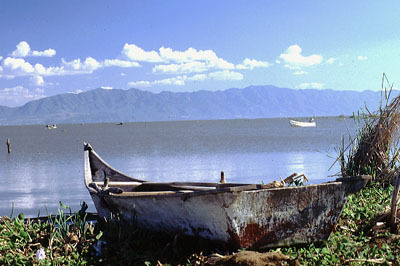
The Symptoms:
- One: Dehydration
- The lake’s first symptom is serious dehydration. Twice this century, the lake has come perilously close to drying up completely. The first crisis was in the 1950s; the second, which still continues, began in 1980. On several occasions, not only has the River Lerma ceased to flow, but the lake shoreline has receded so far that tourists wanting a boat ride have had to board taxis — to get from the pier to the boats! While the first crisis can be attributed to low rainfalls, this second crisis has occurred despite above-average rainfalls since 1960.
Rainfall throughout western Mexico is concentrated into the summer months, bringing Lake Chapala a seasonal thirst. In normal years, the patient receives twice as much water from the Lerma as from rainfall. Of course, the patient also loses water — in an average year, 44 per cent of this loss flows on down the River Santiago, 51 per cent evaporates and most of the remaining 5 per cent is piped to Guadalajara. Currently, the lake is half-full with an average depth of 4.5 metres.
- Two: Muddy water
- The lake water used to be crystal clear but its transparency now rarely exceeds 30 centimetres.
- Three: High phosphorus levels
- Longitudinal studies have revealed a rapid build up of phosphorus in lacustrine sediments. The levels of inorganic phosphorus in the lake water are now several hundred times higher than the levels currently found in any of the Great Lakes and 80 times higher than the maximum concentrations recommended by the U.S. Environmental Protection Agency, USEPA.
- Four: Algal blooms
- In 1994, for the first time in its history, the lake was afflicted by an algal bloom. Blue-green algae gave the water a distinctive smell and taste, neither of which were removed by the treatment given the water prior to its entry into Guadalajara’s potable water system. Fortunately, the species of blue-green algae involved were non-toxic. An algal bloom of toxic species would have disastrous public-health consequences for city residents.
- Five: Heavy metals
- To date, heavy metal levels in lake water have been inside international norms for water suitable for drinking after treatment, but their concentrations in certain aquatic plants, including the water hyacinth (Eichhornia crassipes) and bulrush (Typha latifolia), are far greater. Recent analyses found that water hyacinth samples contained more than 178 milligrams of cyanide, 6 milligrams of chromium and 4 milligrams of lead per (dry) kilogram. Bulrushes fared worse, with concentrations of over 552 milligrams of cyanide and 15 milligrams of mercury per (dry) kilogram. Obviously, this contamination renders the plants unsuitable for processing into mulch, compost or construction material.
- Six: Rashes – infestations of aquatic weeds
- These have become increasingly common. Periodic population explosions of water hyacinth, originally a deliberate ornamental introduction, cover up to 25 per cent of the lake’s surface, posing serious problems for all lake users. Aquatic weeds use more water in evapotranspiration than is lost by evaporation from the equivalent area of open water. They inhibit phytoplankton growth, hinder fishermen, adversely affect property values and pose significant public health risks, since they harbour insect vectors. The health of livestock foraging on such plants is questionable, given their contamination levels. The extent to which these contaminants are transferred to fish or other animals, including humans, in the local food chain remains unclear.
- Seven: Fewer Fish
- The fishing industry is in deep trouble. In the immediate lake basin, more than 2,000 of the 100,000 adult residents depend on fishing for their livelihood. The biodiversity of fish stocks has deceased. The lake once teemed with unique native fish, including three species of highly-prized, delicate-tasting, whitefish (Chirostoma spp). The whitefish catch peaked at 150 tons in 1946 but these clean water, nutrient-sensitive species are now almost extinct. Another native species, popocha (Algansea popoche), was once sold by the canoe-load. It, too, is now virtually extinct. The commercially-important charal (Chirostoma spp) industry is also in decline. All five species of charal are endemics of central Mexico, two are unknown anywhere except Lake Chapala. Taking fishing as a whole, State fisheries department figures show that total catches have declined by 69 per cent over a period of six years.
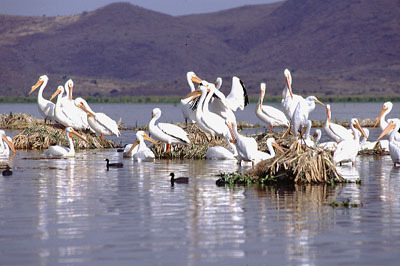
PREVIOUSLY ATTEMPTED REMEDIES:
- One: Amputation
- In 1908, the most biodiverse, healthy and productive extremity of the lake was amputated. Wetlands totalling 500 square kilometres, about one-third of the lake, were drained for farmland. The plan’s proponents argued that reducing the lake’s area would decrease evaporation, and thus guarantee its future!
- Two: Treating the Sores — pin-prick band-aids
- To treat the rashes of water hyacinth, fishermen favored hand-clearing, dumping soggy mounds of the weed to rot on the shore. Their efforts were outpaced by the fast-regenerating plant. A similar problem befell boats with fierce teeth designed to gnash the plant into pieces. The ultimate failure came in mid-1996 when terrestrial bulldozers met a predictable fate in an aquatic environment to which they were singularly unadapted.
- Three: Transplants
- Several species of carnivorous carp (Cyprinus spp) introduced to boost fish stocks a hundred years ago decimated whitefish eggs and fingerlings. Manatees, introduced in the 1950s to eat aquatic weeds, became a casualty of over-zealous fishermen who hunted them out — “beasts that ugly must be the work of the devil”.
- Four: Chemical pills
- A government agency’s plan to use chemical herbicides on the aquatic weeds, though probably sound, never got a fair hearing as Mexico’s fledgling environmental groups beat their drums too loudly.
- Five: Diluting the Problem
- Federal authorities pressured the governors of the five states (Querétaro, Guanajuato, México, Michoacán and Jalisco) comprising the Lerma-Chapala basin to agree on an increased flow of water along the Lerma and to construct numerous water treatment plants.
- Six: Others — Venting Frustration
- Numerous sectors of the community have protested at the lake’s plight. Descendants of the original Coca Indians and Catholic mestizos prayed to their respective Gods. Local non-profits, like the Society for the Defense of Lake Chapala (Motto: Where a lake dies, a desert is born), mobilised people politically. Some extremists openly advocated applying the coup de grâce to the lake by — shades of 1908 — draining it completely!
The Diagnosis: Cultural Eutrophism
This set of symptoms is a classic case of cultural eutrophism, the human-accelerated aging of a lake.
A decreased volume of water has brought adverse changes in depth, temperature gradients, transparency, the area of wetlands and the lake’s ability to recover from drought. The lake declined because insufficient water remained in the Lerma to adequately feed the lake. About 20 per cent of the water extracted from the Lerma is piped to major cities including Mexico City. Most of the remainder is used for irrigation; more than 10,000 dams and dykes now exist along the Lerma and its tributaries. Inefficient, wasteful irrigation techniques are therefore responsible for the lake’s malaise.
Overall, nature provides each inhabitant in the Lerma-Chapala basin with about 1,000 litres of available water per day. This is only one-tenth of the equivalent figure for the whole country. Watertables are dropping and sedimentation rates, provoked by deforestation and land-use changes, increasing.
The lake is being poisoned by the Lerma. People are forcing the Lerma to ingest toxins from agriculture (chemical fertilizers, pesticides and porcine manure), industry (heavy metals) and inadequately treated sewage and domestic wastewater. A recent study of the discharges of nine of the water treatment plants emptying directly into the lake found phosphorus levels 74 times higher than the USEPA norm.
Heavy metal contamination is a particular concern. Investigators have calculated extraordinarily high inputs into certain areas of the Lerma basin. For example, mass budget analysis of local industries (petrochemical, textile, animal products, metallurgy, vehicle assembly, etc.) suggests that more than 12,400 grams of chromium are being added to the basin in the state of Guanajuato — and more than 4,300 grams of zinc in the state of Querétaro — every day!
This rich cocktail of nutrients has caused the blossoming of aquatic weeds. The present eutrophic lake supports a reduced diversity of benthic invertebrates and macrophytes.
THE PROGNOSIS
The lake’s future does not look too promising. As a developing country, Mexico, with half its population under 18 years old and just emerging from its latest economic crisis, faces many demands on its resources. The Lerma-Chapala basin, due to its complexity and level of industrialization, falls outside Mexico’s existing network of biosphere reserves, national parks and other conservation areas.
Given the circumstances, it would be socially irresponsible and naive to suggest “protecting” or “conserving” Lake Chapala without first trying to ensure improved living standards for all the basin’s 8 million inhabitants. This number is growing rapidly. Not only have the cities of the Lerma basin grown at 2.5 per cent per year since 1980 but, at the same time, this region, more than any other in Mexico, has exported its “surplus” labor to the U.S.
This flow of out-migration, the region’s “safety valve” according to some economists, could swell to alarming proportions in the future if, with increased population, water resources in the basin become stressed to breaking point. The resulting pressure from this wave of migration would be felt far to the north, on the U.S.-Mexico border. A water crisis would precipitate the demise of Lake Chapala, heralding irreversible changes in the climate of Mexico’s “bread basket”, in avian migrations and in the retirement options of thousands of Canadian and American retirees.
The Planned Treatment: A Holistic Approach with International Support
Resolving the predicament of Lake Chapala clearly requires an international effort. There is a precedent. In the 1980s, Canadian diplomatic initiatives helped to convince Mexico to take immediate action to safeguard the monarch butterfly’s overwintering fir-forest habitats in Michoacán. The resulting international project correctly assumed that existing inhabitants would play an important part in preserving the biodiversity of their own landscape. A dying lake may not be as photogenic as a monarch butterfly, but Lake Chapala is vital to the people and wildlife of all three North American countries. International pressure can help garner the support needed for measures to be enacted to stem the ever-rising tide of problems confronting the entire Lerma-Chapala ecosystem.
Dr. Len Simser, an environmental biologist at Canada’s Royal Botanical Gardens, came to the same conclusion after visiting the University of Guadalajara’s Limnology Institute in Chapala. Simser, who worked on Lake Ontario’s Hamilton Harbour Remedial Action Plan, professed himself “struck by the similarities in context which have given rise to the ecological problems in Hamilton Harbour and Lake Chapala” and emphasized the need for “co-operative habitat preservation and restoration programs with other nations.”
The Limnology Institute’s director, Dr. Manuel Guzmán, subsequently arranged for Dr. Harvey Shear, an Environment Canada expert on joint U.S.-Canada Great Lakes Management programs, to address the “1st International Seminar on Lake and River Rehabilitation” held in Guadalajara in June 1996. The event, organised by Jalisco’s scientific and technical research body, CIATEJ (Centro de Investigación y Asistencia Tecnológica y Diseño del Estado de Jalisco, A.C.) attracted many of Mexico’s leading water-quality researchers and policy makers. It focused its attention firmly on Lake Chapala.
In the past few months, a promising follow-up initiative, using an approach entirely new in Mexico, has been launched by Guzmán, CIATEJ environmental engineer José de Anda and other researchers. Their plan, too, foresees international support playing a key role. Acknowledging that “quick fix” strategies have never more than temporarily masked the symptoms, they propose instead a vast, ecosystem-based “master-plan” for the entire Lerma-Chapala basin. The “master-plan” focuses attention exactly where it belongs — on the health and well-being of the ecosystem as a whole, especially the health of the 8 million people who form an integral part of it. The new group is, in other words, adopting a holistic approach to solving the problems.
This new multi-institutional proposal to “Evaluate Lake Chapala’s Water Quality and its Repercussions on Public Health and Fish Production” calls for a diagnostic phase, followed by experimental testing and constant dialogue with all the varied groups living in the basin. Agreed-upon remedial measures will be jointly coordinated and carried out. The importance of a rational, sustainable use of all available resources will be stressed. Follow-up visits will include regular monitoring of key indicators and the modifying, if necessary, of the prescribed treatment. No surgery! No band-aids!
The proposal has been greeted with positive noises from likely sources of international funding. Eventually, many parts of future management programs would have to become self-financing. Restored wetlands might once again provide havens for migratory birds and become the focus of an eco-tourism industry, for example.
The new plan has several things going for it. First, the link being forged between CIATEJ and Environment Canada will enable Mexican scientists to draw on decades of Great Lakes rehabilitation experience. It will also help ensure that research done in Mexico matches any relevant international norms. At the same time, the project can take advantage of various existing academic cooperation accords between Mexico and its NAFTA partners.
Perhaps this proposal’s greatest strength is that it brings together specialists from diverse fields and institutions, recognising that conventional academic institutional structures and traditional systematic subject boundaries have often proved inadequate for investigating the sustainable development of drainage basins.
This new multidisciplinary and multi-institutional group has an exciting trinational challenge ahead — to design and implement a joint conservation and restoration effort — not just for the well-being of the 8 million people in the biodiverse Lerma-Chapala basin, but for the well-being of all North Americans.
“EVALUATION OF LAKE CHAPALA’S WATER QUALITY
AND ITS REPERCUSSIONS ON PUBLIC HEALTH AND FISHERIES”
- Objectives
- 1. The improved training of specialists, by postgraduate academic exchanges and by close collaboration with the various official dependencies concerned with water and health issues and policy
- 2. Identification of contaminants and other elements affecting water quality and studies of their precise mode of operation
- 3. Identification of the principal point and non-point sources of contamination in the basin
- 4. An epidemiological study to identify public health problems in the region
- 5. A study of the relationships between flora and fauna and the levels of water contamination
- 6. The development of the appropriate technology to bring point source discharges inside international norms
- 7. The establishing of rehabilitation strategies to reduce non-point sources of contamination, including zoning measures and the use of appropriate techniques of irrigation
- 8. Participation in programs to resolve public health problems linked to water quality
- Methodology
- 1. Bibliographic analysis, and compilation of a data bank containing information already collected by the National Water Commission and other government agencies
- 2. Analysis of the data bank using Geographic Information Systems and Environment Canada’s RAISON program
- 3. Extensive long-term field monitoring of water, sediment, aquatic weed and fish quality parameters
- 4. Identification and quantification of biological nutrients, especially phosphorus and nitrogen in all their forms
- 5. Identification and quantification of pesticides commonly used in the basin
- 6. Measurement of heavy metal and pesticide levels in fish
- 7. An epidemiological study of the principal health problems in the Chapala region, reviewing official health statistics, conducting questionnaire surveys and evaluating possible risk factors
- 8. Analysis of results and formulation of recommendations
References
- de Anda, J. & C. J. Uribe-Hernández. ¿Es posible combatir la maleza del Lago de Chapala? in El Financiero newspaper, 30 September, 1996.
- Guzmán-Arroyo, M. 1995. La Pesca en el Lago de Chapala: hacia su ordenamiento y explotación racional. Universidad de Guadalajara, Mexico.
- Hansen, A.M., A. León-Zavala & L. Bravo-Inclán. 1995. Fuentes de contaminación y enriquecimiento de metales en sedimentos de la cuenca Lerma-Chapala. Ingeniería Hidráulica en México, Vol. X, No. 3: 55-69.
- Limón-Macías, G. 1996. Respuesta del Lago de Chapala a Esfuerzos de Manejo. Lecture delivered June 15 at the Ist International Seminar, Tecnicas y metodos actuales para la rehabilitación de lagos y ríos. Guadalajara, México.
This article first appeared in “ECODECISION” an environmental and policy magazine. Vol. 23, Winter 1997
This article is Part 1 of Tony Burton’s series:
“Can Mexico’s Largest Lake be Saved?”
Part 2: March, 2000 – The State of The Lake.
Part 3: March, 2001 – The Future of Lake Chapala–Suggestions For Discussion
Part 4: May 2002 – Lake Chapala–Fish Farm, Farmland or Bungee Jump?
Part 5: April 2003 – A review of “The Lerma-Lake Chapala watershed: evaluation and management”

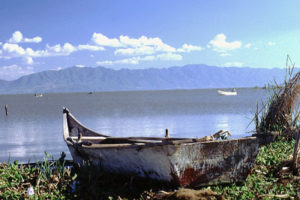
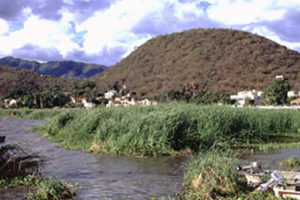
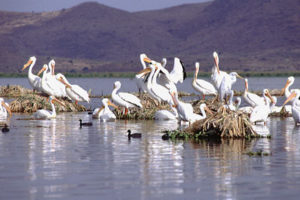
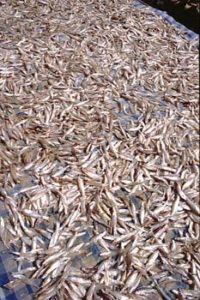
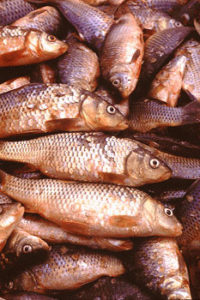

This article was published in 1997! A current assessment of the situation would be welcome.
Valerie Dolegowski: Did Valerie recieve a current assessment of how much of this great plan has been realized (27 years ago)? Thanks for the update